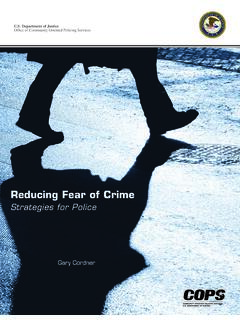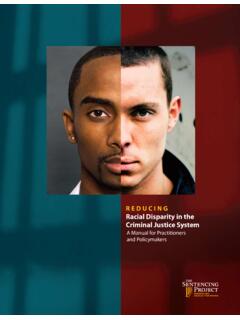Transcription of Effectiveness of Police in Reducing Crime and the Role of ...
1 40 CHAPTER 1 CHAPTER 3 Effectiveness of Police in Reducing Crime and the Role of Crime AnalysisChapter 2 presents the theoretical foundation for understanding how Crime and disorder occur; it also details ways to reduce opportunities and prevent problematic activity, based on theory. This chapter links these theoretical concepts with Crime reduction practice by Police . As dis-cussed in Chapter 1, the primary purpose of Crime analysis is to assist Police ; the focus of this chapter is on what works in policing for preventing and controlling Crime and the role of Crime analysis in assisting with these efforts.
2 Importantly, research and practice have shown the most effective methods Police employ to prevent and control Crime are those in which Crime analysis plays a vital Effectiveness in Preventing and Controlling CrimeIn the last 30 years, American policing has seen significant changes in both thinking and practice (Weisburd & Braga, 2006a). Technological advances, new perspectives on policing, and evaluations of current practices have brought about these changes. A number of Police scholars as well as the National Academy of Sciences Committee to Review Research on Police Policies and Practice have examined exist-ing research to determine what works for preventing and controlling Crime in policing (Sherman et al.)
3 , 1997; Skogan & Frydl, 2004; Weisburd & Eck, 2004). The following is a brief overview of the key elements and research results for the most notable Police strategies the standard model of policing, commu-nity policing, broken windows policing, hot spots policing, Compstat, and problem-oriented Model of PolicingThe standard model of policing encompasses strategies that come to mind when the average per-son thinks about what Police are supposed to do. The central element of the standard model Effectiveness of Police in Reducing Crime and the Role of Crime Analysis 41involves enforcing the law in a broad and reactive way, primarily using Police resources (Weisburd & Eck, 2004).
4 Specifically, the strategies of the standard model of policing include the following (Sherman et al., 1997; Weisburd & Eck, 2004): Increased number of Police officers (to increase the ability to detect Crime and arrest offenders) Unfocused, random motorized patrols (to create a perception of a Police omnipresence to deter Crime in public places) Rapid response to calls for service (to increase the likelihood of catching offenders) Follow-up investigations by detectives (to increase the solvability of the crimes)
5 General reactive arrest policies (to deter and punish specific offenders as well as deter the general public from committing crimes)There have been only a limited number of evaluations of these strategies; the available research shows that each one of these generally applied enforcement efforts has been of limited Effectiveness (Sherman et al., 1997; Skogan & Frydl, 2004; Weisburd & Eck, 2004).Community PolicingPolice scholars have touted community policing as one of the most widely adopted Police strategies in the last several decades (Weisburd & Eck, 2004).
6 However, it is difficult to define, because its definition has changed over time, and its concepts are vague. The key elements of community polic-ing are that Police must work with the community and draw from other resources outside the Police to prevent and solve Crime problems. According to the Department of Justice s Office of Community Oriented Policing (2011a), community policing isA philosophy that promotes organizational strategies which support the systematic use of partnerships and problem-solving techniques, to proactively address the immediate con-ditions that give rise to public safety issues such as Crime , social disorder, and fear of Crime .
7 (para. 1)Because community policing is difficult to define and has evolved from being considered a strategy to being considered a philosophy, overall it is difficult to evaluate. However, specific strate-gies have been used primarily to represent community policing in evaluations. One strategy is neighborhood watch (also called block watch), which is one of the most implemented community policing programs; it has the goal of increasing surveillance by residents and community members of their own neighborhoods.
8 Other strategies include increasing the flow of information from the community to the Police through community meetings, officers walking the beat and talking to residents, and storefront beat offices; and providing Crime information to the public through the Internet, Crime maps, letters, and reverse 911 phone calls so they can protect themselves (Sherman et al., 1997).The overall results of research evaluations of community policing show that neighborhood watch, community meetings, storefront offices, and newsletters do not reduce Crime (Weisburd & Eck, 2004).
9 While door-to-door visits by the Police have been found to reduce Crime , simply providing information about Crime to the public has not been shown to prevent Crime (Sherman et al., 1997; Weisburd & Eck, 2004). Consequently, overall community policing as measured by these specific strategies does not seem to increase Police Effectiveness at prevent-ing Crime ; however, it has been shown to reduce fear of Crime (Weisburd & Eck, 2004). 42 FOUNDATIONS OF Crime ANALYSISH owever, the philosophy that Police should engage the community and partner with them to deal with problems is one to which most Police departments in the United States Windows PolicingBroken windows policing (also called zero tolerance policing) is based on practical theory devel-oped in the 1980s (Wilson & Kelling, 1982).
10 It focuses on the strict enforcement of laws against disorderly behavior and minor offenses (considered quality of life offenses), such as prostitution, public urination, and aggressive panhandling (Sousa & Kelling, 2006). The intent is to prevent more serious crimes from happening. The term broken windows is a metaphor that alludes to the fact that if a broken window is left unfixed, it indicates that no one cares and invites more broken win-dows and more serious criminal behavior (Sousa & Kelling, 2006).














